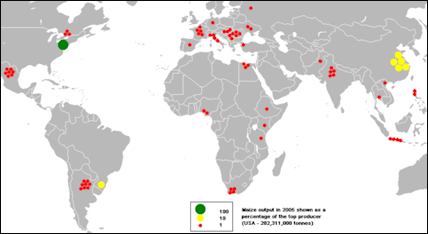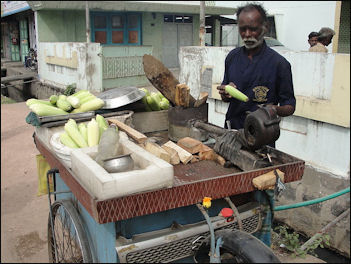CORN AND MAIZE

Corn is the world’s No.1 grain in terms of production but only No.3 as dietary staple after rice and wheat, accounting for 5 percent of the world’s human caloric intake. The reason for this discrepancy is that most corn is raised primarily as livestock feed. There are over 300 different "races" of corn. In most parts of the world corn is called maize. [Source: Robert Rhoades, National Geographic, June 1993, ╖]
Corn kernels are the main source of food. They are wrapped in a tough, fibrous outer hull which makes up about 3 percent of the kernel. The germ makes up 4.5 percent. The remainder is the endosperm. Corn kernels contains about 10 to 25 percent water depending on the conditions it is grown. Of the dry portion about 10 percent is protein, 10 percent is fiber, minerals and fat and 80 percent is carbohydrates. The protein, called gluten, is nutritious and provides a stickiness useful in trapping yeast and making bread. Most of the carbohydrates are in the form of starch.
Corn crops yield canned corn, corn on the cob, corn oil, corn meal, breakfast cereals, corn sugar, corn syrup alcohol for whiskeys, margarine, livestock feed, fibers used in inks and lacquers, and starch used in paper and textile manufacturing and numerous other products. Scientists are now experimenting with other uses for corn such as corn starch packing peanuts and biodegradable corn-based golf tees. Corn can be made into sugar-based ethanol which can be mixed with gasoline.╖
Over half of the world's corn supply is grown in the United States, where surprisingly only 1.4 percent of it ends up on the dinner table eaten as whole kernel or processed corn. Most of it is used as animal feed. In 2006, corn prices were very high. The high prices were attributed to high oil prices and increased demand for corn to make ethanol and increased demand from China. Some worry that demand for ethanol will mean less food and more starving people.
Overall, very little corn is consumed on the cob or even is cans or frozen packets. Much of the corn in the United States is grown for animal feed and corn syrup and corn sugar for processed foods. Most corn that is produced is worldwide is used for livestock feed. In many parts of the world where it is eaten by humans it is ground into flour and consumed as bread, tortillas or porridge.
Websites and Resources: University of Iowa Corn Page agronext.iastate.edu ; National Corn Growers Association ncga.com ; Corn Growers Guidebook agry.purdue.edu ; History of Corn New York Times ; Wikipedia article Wikipedia ;U.S. Grains Council grains.org/corn ; International Maize and Wheat Improvement Center cimmyt.org ;
World’s Top Maize (Corn) Producing Countries
World’s Top Producers of Maize (Corn) (2020): 1) United States: 360251560 tonnes; 2) China: 260670000 tonnes; 3) Brazil: 103963620 tonnes; 4) Argentina: 58395811 tonnes; 5) Ukraine: 30290340 tonnes; 6) India: 30160000 tonnes; 7) Mexico: 27424528 tonnes; 8) Indonesia: 22500000 tonnes; 9) South Africa: 15300000 tonnes; 10) Russia: 13879210 tonnes; 11) Canada: 13563400 tonnes; 12) France: 13419140 tonnes; 13) Nigeria: 12000000 tonnes; 14) Romania: 10942350 tonnes; 15) Ethiopia: 10022286 tonnes; 16) Pakistan: 8464885 tonnes; 17) Hungary: 8365430 tonnes; 18) Philippines: 8118546 tonnes; 19) Serbia: 7872607 tonnes; 20) Egypt: 7500000 tonnes. [Source: FAOSTAT, Food and Agriculture Organization (U.N.), fao.org. A tonne (or metric ton) is a metric unit of mass equivalent to 1,000 kilograms (kgs) or 2,204.6 pounds (lbs). A ton is an imperial unit of mass equivalent to 1,016.047 kg or 2,240 lbs.]
top maize producersWorld’s Top Producers (in terms of value) of Maize (Corn) (2019); 1) United States: Int.$69663519,000 ; 2) China: Int.$52346645,000 ; 3) Brazil: Int.$20301747,000 ; 4) Argentina: Int.$11413757,000 ; 5) Ukraine: Int.$7202271,000 ; 6) Indonesia: Int.$6161136,000 ; 7) India: Int.$5563305,000 ; 8) Mexico: Int.$5465577,000 ; 9) Romania: Int.$3499203,000 ; 10) Russia: Int.$2866924,000 ; 11) Canada: Int.$2690590,000 ; 12) France: Int.$2578405,000 ; 13) South Africa: Int.$2263353,000 ; 14) Nigeria: Int.$2208051,000 ; 15) Ethiopia: Int.$1934199,000 ; 16) Hungary: Int.$1651961,000 ; 17) Philippines: Int.$1601609,000 ; 18) Egypt: Int.$1495453,000 ; 19) Serbia: Int.$1474284,000 ; [An international dollar (Int.$) buys a comparable amount of goods in the cited country that a U.S. dollar would buy in the United States.]
Top maize-producing countries in 2008: (first, Production, $1000; second, production in metric tons. FAO): 1) United States of America, 20261250 , 307142010; 2) China, 6959063 , 166032097; 3) Argentina, 2042438 , 22016926; 4) Brazil, 1925338 , 58933347; 5) India, 1442042 , 19730000; 6) Mexico, 1292539 , 24320100; 7) Indonesia, 1286208 , 16323922; 8) South Africa, 1004019 , 12700000; 9) France, 908509 , 15818500; 10) Nigeria, 688353 , 7525000; 11) Hungary, 685763 , 8897138; 12) Canada, 451757 , 10592000; 13) Ethiopia, 424389 , 3776440; 14) United Republic of Tanzania, 392414 , 3659000; 15) Ukraine, 357746 , 11446800; 16) Pakistan, 311997 , 3593000; 17) Philippines, 275573 , 6928220; 18) Kenya, 259502 , 2367237; 19) Malawi, 255983 , 2634701; 20) Romania, 247997 , 7849080;
History of Corn
Some scientists believe that the corn from teosinte a weedy wild grass still found in remote areas of Mexico that has inch-long "ears" and look more like wheat than corn. Other believe it comes from criollo, a plant native to a remote region of Sierre Norte de Oaxaca in Mexico, or cornlike plant that has since become extinct. Primitive corncobs from these plants found in a Oaxaca cave were dated to 6,300 B.C.
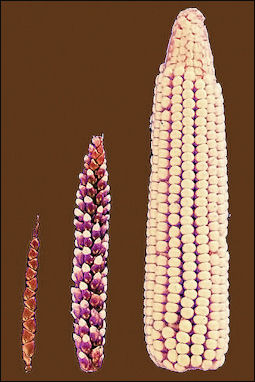
teosinte on the left In 2001, based of DNA studies, scientists concluded that corn did in fact evolve from teosinte. It is believed that ancient people in southern Mexico and Central America began harvesting grains from wild teosinte about 10,000 years. Through selective breeding these plants developed large stalks and seeds and eventually these became the cobs we associate with corn today.
People in the New World ate a variety of corn products. The Mayans drank “atole” , a thick beverage made from fermented corn meal. Popcorn was invented in Peru. In 1493 Columbus carried corn from the New World back to Spain. At first it was treated as a novelty by botanists, but within a hundred years it was widely grown not only in Europe but also in Africa and Asia.
Indian corn came in a variety of colors. Europeans preferred the yellow variety. Over time scientists created hybrids with desirable characteristics that resulted in the corns were are familiar with today. Some were bred for eating. Others were bred to produce large quantities of food. New varieties of corn were one of the cornerstones for the Green Revolution in the 1970s. But unfortunately the drive to create a few high-yield species has caused many other varieties to disappear. Only 20 percent of the corn recorded in Mexico in 1930 can be found today.
Corn Agriculture
Mature corn plants can grow over 40 feet high but most are between six and 20 feet high. At the top of the plant is a spiked tassel. Further down are one of more spikes that develop into ears, which grow from the beneath the leaves. Certain agricultural techniques have been developed for specific varieties of corn. Great care has to be taken though not to injure the shallow grasslike roots.
Corn has many advantages over other grains. It can be harvested every 120 days and grows in a wide variety of habitats: rain forests with poor soils, deserts with 115̊F temperatures, 12,000-foot-high mountain terraces, and glacier scoured land near the Arctic.
Corn needs lots of sun; requires the clearing of land to cultivate; grows best in well drained soils; and often need a lot of water. Because corn requires more nutrients than some other grains it often is rotated in a three-year cycle when a enough fertilizer isn't available. Legume, alfalfa or sweet clover are planted the first year to provide enough nitrogen. The second year corn is grown. The following year a small grain is cultivated. Then the three-year cycle is repeated.
Most corn is harvested with mechanical pickers. The entire corn plant is often harvested and stored in a silo. After it has dried the grain is removed. The stalks and leaves are often used in livestock feed.
Corn is vulnerable to a number of pests and diseases. The corn crop in the United States the 1970s was devastated by an unusual fungus. the problem was remedied by modifying seeds s they contained a gene from the a type of African maize resistant to disease.
Corn Advances

teosinte in Oaxaca New plant varieties and advances in technology have boosted corn yields by nearly 80 percent. The National Agricultural Research Organization of Uganda has developed corn varieties that do well in nitrogen-poor soil and are more resistant to disease. Not all the new varieties are perfect. Drought-resistance corns suffer in freak rains.
In Britain, biodegradable bottles made from corn are used in Belu bottled water. Ingeo, fabric made from corn, is biodegradable and has been used in hiking socks by Teko and chic fashions by NatureVsFuture.
Genetically-modified (GM) versions of corn are now widely used. Just two engineered traits are sold: 1) resistance to glyphosate, a herbicide used to kill weeds and crops; 2) use of BT, a microorganism that produces chemicals that are toxic to insects not humans.
There are worries that GM crops could spread unpredictably and that genetic diversity will be compromised. Local varieties of corn in Mexico have already been contaminated by GM varieties even though GM corn are banned in Mexico. Mexico approved the use of GM corn in 2008 on a limited basis but only after a buffer zone was set up to protect native species.
Corn Bioethanol
The main sources for biofuel at this time are palm oil, rapeseed (colza), sunflowers, sugar cane, corn, and jatropha. New processes that can turn woody, weedy plants like switch grass, poplar, wheat straw and corn stalks into cellulosic ethanol.
Biofuel sources (gallons per acre): 1) sugar beets (714); 2) sugar cane (662); 3) cassava (410); 4) sorghum (374); 5) corn (354).
There are two main kinds of ethanol: 1) corn ethanol derived from corn, sugar cane and soy beans; and 2) cellulosic ethanol derived from plants like switchgrass (summer grass) , wood chips, agricultural wastes such as stalks and leaves and husks, forest waste such as bark and sawdust, paper pulp and timber chip. The latter produces more energy than corn ethanol but takes more energy to manufacture.
Corn is made into ethanol by grinding the corn, mixing it with water and heating it. Enzymes are added that convert starch to sugar. Fermentation turns the sugar into alcohol, which is separated from the water by distillation. Waste solids are fed to livestock. Wastewater can be made into fertilizer. The biggest drawback with the process — especially if coal energy is used to provide heat for distillation — is that it produces a lot of carbon dioxide.
In 2007, about 25 percent of the total corn crop of the United States was used for biofuel. The demand for corn for biofuels helped boost corn prices to a record high of $288.10 per ton in June 2008. Corn isn’t the best biofuel crop . It requires large amounts of herbicides and nitrogen fertilizer and can cause soil erosion. Producing it requires about as much energy as is produced by the fuel. Corn-based ethanol produces carbon dioxide but about 15 percent less than gasoline.
World’s Top Maize (Corn) Exporting Countries
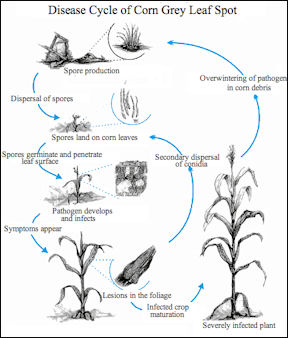
World’s Top Exporters of Maize (Corn) (2020): 1) United States: 51838933 tonnes; 2) Argentina: 36881996 tonnes; 3) Brazil: 34431936 tonnes; 4) Ukraine: 27952483 tonnes; 5) Romania: 5651064 tonnes; 6) France: 4558720 tonnes; 7) Hungary: 4040502 tonnes; 8) Serbia: 3608208 tonnes; 9) South Africa: 2584946 tonnes; 10) Bulgaria: 2559570 tonnes; 11) Russia: 2289269 tonnes; 12) Paraguay: 2106920 tonnes; 13) India: 1766876 tonnes; 14) Poland: 1490378 tonnes; 15) Croatia: 1213051 tonnes; 16) Myanmar: 1191119 tonnes; 17) Canada: 1132480 tonnes; 18) Netherlands: 849256 tonnes; 19) Slovenia: 841207 tonnes; 20) Slovakia: 619203 tonnes. [Source: FAOSTAT, Food and Agriculture Organization (U.N.), fao.org]
World’s Top Exporters (in value terms) of Maize (Corn) (2020): 1) United States: US$9575254,000; 2) Argentina: US$6046745,000; 3) Brazil: US$5853003,000; 4) Ukraine: US$4885125,000; 5) France: US$1711436,000; 6) Romania: US$1234562,000; 7) Hungary: US$997546,000; 8) Serbia: US$665307,000; 9) South Africa: US$566234,000; 10) Bulgaria: US$497072,000; 11) Russia: US$395244,000; 12) India: US$389280,000; 13) Myanmar: US$382695,000; 14) Paraguay: US$322343,000; 15) Poland: US$321528,000; 16) Austria: US$284794,000; 17) Canada: US$250141,000; 18) Netherlands: US$235694,000; 19) Croatia: US$226688,000; 20) Germany: US$155549,000
World’s Top Exporters of Maize (Corn), Green (2020): 1) United States: 62914 tonnes; 2) Spain: 59043 tonnes; 3) Mozambique: 22672 tonnes; 4) Morocco: 16923 tonnes; 5) France: 15662 tonnes; 6) Poland: 13357 tonnes; 7) Slovakia: 10877 tonnes; 8) United Kingdom: 4163 tonnes; 9) Honduras: 3400 tonnes; 10) Bulgaria: 2798 tonnes; 11) Hungary: 2745 tonnes; 12) Portugal: 2661 tonnes; 13) Netherlands: 2563 tonnes; 14) Bangladesh: 529 tonnes; 15) Romania: 528 tonnes; 16) Austria: 503 tonnes; 17) Ghana: 316 tonnes; 18) Greece: 296 tonnes; 19) Iran: 250 tonnes; 20) Belgium: 203 tonnes
World’s Top Exporters (in value terms) of Maize (Corn), Green (2020): 1) United States: US$54307,000; 2) Spain: US$50710,000; 3) Morocco: US$14824,000; 4) United Kingdom: US$12003,000; 5) France: US$8836,000; 6) Honduras: US$8404,000; 7) Netherlands: US$4031,000; 8) Poland: US$3788,000; 9) Slovakia: US$3117,000; 10) Bangladesh: US$1739,000; 11) Hungary: US$1692,000; 12) Portugal: US$994,000; 13) Ghana: US$966,000; 14) Austria: US$852,000; 15) Belgium: US$752,000; 16) Bulgaria: US$671,000; 17) Romania: US$664,000; 18) Ethiopia: US$515,000; 19) Germany: US$395,000; 20) Iran: US$248,000
World’s Top Maize (Corn) Importing Countries
corn field World’s Top Importers of Maize (Corn) (2019): 1) Mexico: 16524045 tonnes; 2) Japan: 15986093 tonnes; 3) Vietnam: 11447667 tonnes; 4) South Korea: 11366877 tonnes; 5) Spain: 10012619 tonnes; 6) Egypt: 8078446 tonnes; 7) Iran: 7388742 tonnes; 8) Italy: 6394217 tonnes; 9) Netherlands: 6383336 tonnes; 10) Colombia: 5992611 tonnes; 11) Taiwan: 4806245 tonnes; 12) China: 4791058 tonnes; 13) Germany: 4562511 tonnes; 14) Algeria: 4356206 tonnes; 15) Turkey: 4347475 tonnes; 16) Peru: 4009801 tonnes; 17) Malaysia: 3755359 tonnes; 18) Saudi Arabia: 3260945 tonnes; 19) United Kingdom: 2781577 tonnes; 20) Morocco: 2731200 tonnes. [Source: FAOSTAT, Food and Agriculture Organization (U.N.), fao.org]
World’s Top Importers (in value terms) of Maize (Corn) (2019): 1) Japan: US$3524630,000; 2) Mexico: US$3190075,000; 3) South Korea: US$2352948,000; 4) Vietnam: US$2312953,000; 5) Egypt: US$1929765,000; 6) Spain: US$1928324,000; 7) Iran: US$1592255,000; 8) Netherlands: US$1361583,000; 9) Italy: US$1244456,000; 10) Colombia: US$1190541,000; 11) Germany: US$1111419,000; 12) China: US$1061586,000; 13) Taiwan: US$979563,000; 14) Turkey: US$847519,000; 15) Peru: US$796540,000; 16) Algeria: US$794654,000; 17) Malaysia: US$787326,000; 18) Saudi Arabia: US$715322,000; 19) Venezuela: US$618394,000; 20) United Kingdom: US$595127,000
World’s Top Corn Flour Exporting Countries
World’s Top Exporters of Maize (Corn) Flour (2020): 1) South Africa: 549485 tonnes; 2) United States: 244347 tonnes; 3) Mexico: 232666 tonnes; 4) Brazil: 185268 tonnes; 5) Turkey: 135205 tonnes; 6) Pakistan: 89170 tonnes; 7) Italy: 86738 tonnes; 8) France: 80751 tonnes; 9) El Salvador: 74068 tonnes; 10) Spain: 72918 tonnes; 11) India: 64040 tonnes; 12) Poland: 63852 tonnes; 13) Uganda: 63036 tonnes; 14) Zambia: 53567 tonnes; 15) Germany: 50607 tonnes; 16) Canada: 49963 tonnes; 17) Hungary: 48058 tonnes; 18) Dominican Republic: 46181 tonnes; 19) Colombia: 41819 tonnes; 20) Belgium: 41529 tonnes. [Source: FAOSTAT, Food and Agriculture Organization (U.N.), fao.org]
World’s Top Exporters (in value terms) of Maize (Corn) Flour (2020): 1) South Africa: US$167224,000; 2) Mexico: US$131517,000; 3) United States: US$123401,000; 4) Brazil: US$67062,000; 5) Italy: US$58755,000; 6) France: US$41226,000; 7) Turkey: US$37849,000; 8) El Salvador: US$35336,000; 9) Colombia: US$34856,000; 10) Spain: US$27568,000; 11) Uganda: US$26166,000; 12) Germany: US$25507,000; 13) Poland: US$22644,000; 14) India: US$21857,000; 15) Dominican Republic: US$19098,000; 16) Zambia: US$16295,000; 17) Canada: US$15831,000; 18) Belgium: US$15608,000; 19) Hungary: US$13802,000; 20) Honduras: US$11208,000
World’s Top Maize (Corn) Oil Producing and Exporting Countries
roadside maize vendor World’s Top Producers of Maize (Corn) Oil (2019): 1) United States: 1774200 tonnes; 2) China: 514000 tonnes; 3) Brazil: 168177 tonnes; 4) South Africa: 84800 tonnes; 5) Japan: 80731 tonnes; 6) Italy: 71700 tonnes; 7) France: 69500 tonnes; 8) Belgium: 65600 tonnes; 9) Canada: 63100 tonnes; 10) Turkey: 56800 tonnes; 11) South Korea: 51730 tonnes; 12) Argentina: 48300 tonnes; 13) Venezuela: 41373 tonnes; 14) Hungary: 40200 tonnes; 15) Mozambique: 36580 tonnes; 16) Mexico: 33468 tonnes; 17) Spain: 32500 tonnes; 18) United Kingdom: 30900 tonnes; 19) North Korea: 30245 tonnes; 20) Tanzania: 25402 tonnes. [Source: FAOSTAT, Food and Agriculture Organization (U.N.), fao.org]
World’s Top Exporters of Maize (Corn) Oil (2020): 1) United States: 214321 tonnes; 2) Turkey: 61395 tonnes; 3) Hungary: 32185 tonnes; 4) Brazil: 31938 tonnes; 5) Belgium: 26242 tonnes; 6) Saudi Arabia: 24268 tonnes; 7) Canada: 20630 tonnes; 8) Argentina: 16623 tonnes; 9) South Korea: 15944 tonnes; 10) Italy: 14815 tonnes; 11) Paraguay: 14255 tonnes; 12) France: 13894 tonnes; 13) United Arab Emirates: 12833 tonnes; 14) Egypt: 11322 tonnes; 15) Germany: 10357 tonnes; 16) Ukraine: 9772 tonnes; 17) China: 9467 tonnes; 18) Malaysia: 9256 tonnes; 19) Austria: 9252 tonnes; 20) Spain: 8812 tonnes
World’s Top Exporters (in value terms) of Maize (Corn) Oil (2020): 1) United States: US$198434,000; 2) Turkey: US$75701,000; 3) Saudi Arabia: US$50405,000; 4) Belgium: US$29324,000; 5) Hungary: US$26535,000; 6) Brazil: US$25809,000; 7) United Arab Emirates: US$19379,000; 8) Italy: US$18178,000; 9) Austria: US$17335,000; 10) South Korea: US$16225,000; 11) France: US$15277,000; 12) Canada: US$15069,000; 13) Malaysia: US$15059,000; 14) Argentina: US$13743,000; 15) China: US$12423,000; 16) Egypt: US$11613,000; 17) Spain: US$10540,000; 18) Germany: US$9325,000; 19) Ukraine: US$8848,000; 20) Tunisia: US$8600,000
World’s Top Sweet Corn Exporting Countries
World’s Top Exporters of Frozen Sweet Corn (2020): 1) United States: 73099 tonnes; 2) Hungary: 53477 tonnes; 3) China: 40353 tonnes; 4) France: 34472 tonnes; 5) Spain: 32921 tonnes; 6) Belgium: 21064 tonnes; 7) Thailand: 20956 tonnes; 8) India: 17912 tonnes; 9) Canada: 17609 tonnes; 10) Poland: 15753 tonnes; 11) Vietnam: 11246 tonnes; 12) New Zealand: 10337 tonnes; 13) Serbia: 8877 tonnes; 14) Slovakia: 7364 tonnes; 15) Netherlands: 4770 tonnes; 16) Peru: 4260 tonnes; 17) Malaysia: 3157 tonnes; 18) Turkey: 3106 tonnes; 19) Austria: 2774 tonnes; 20) Belarus: 1883 tonnes. [Source: FAOSTAT, Food and Agriculture Organization (U.N.), fao.org]
World’s Top Exporters (in value terms) of Frozen Sweet Corn (2020): 1) United States: US$95331,000; 2) Hungary: US$55224,000; 3) Spain: US$33324,000; 4) France: US$32029,000; 5) China: US$31249,000; 6) Belgium: US$27241,000; 7) Thailand: US$20939,000; 8) Canada: US$17241,000; 9) Poland: US$15694,000; 10) Vietnam: US$13892,000; 11) New Zealand: US$13612,000; 12) India: US$12833,000; 13) Peru: US$8825,000; 14) Serbia: US$7749,000; 15) Netherlands: US$7559,000; 16) Austria: US$3530,000; 17) Slovakia: US$3185,000; 18) Malaysia: US$2988,000; 19) Turkey: US$2924,000; 20) Germany: US$2687,000
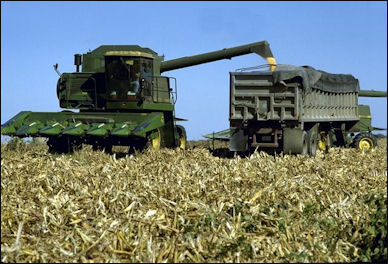
corn harvestingWorld’s Top Exporters of Prepared or Preserved Sweet Corn (2020): 1) Thailand: 213455 tonnes; 2) Hungary: 192761 tonnes; 3) France: 130096 tonnes; 4) China: 77955 tonnes; 5) United States: 70470 tonnes; 6) Belgium: 21861 tonnes; 7) Brazil: 18349 tonnes; 8) Russia: 17975 tonnes; 9) Spain: 16292 tonnes; 10) Netherlands: 9559 tonnes; 11) Germany: 9475 tonnes; 12) Vietnam: 7142 tonnes; 13) Italy: 5395 tonnes; 14) Poland: 4661 tonnes; 15) Uzbekistan: 2619 tonnes; 16) Republic of Moldova: 2481 tonnes; 17) Canada: 2323 tonnes; 18) Peru: 1685 tonnes; 19) United Kingdom: 1630 tonnes; 20) New Zealand: 1619 tonnes
World’s Top Exporters (in value terms) of Prepared or Preserved Sweet Corn (2020): 1) Hungary: US$227809,000; 2) Thailand: US$216275,000; 3) France: US$191850,000; 4) China: US$126305,000; 5) United States: US$86011,000; 6) Spain: US$38247,000; 7) Belgium: US$36248,000; 8) Russia: US$19378,000; 9) Netherlands: US$18935,000; 10) Brazil: US$15819,000; 11) Germany: US$14919,000; 12) Italy: US$9079,000; 13) Vietnam: US$7906,000; 14) Poland: US$5085,000; 15) Uzbekistan: US$3939,000; 16) United Kingdom: US$3638,000; 17) New Zealand: US$2750,000; 18) Republic of Moldova: US$2679,000; 19) Canada: US$2663,000; 20) Mexico: US$2020,000
Image Sources: Wikimedia Commons
Text Sources: National Geographic, New York Times, Washington Post, Los Angeles Times, Smithsonian magazine, Natural History magazine, Discover magazine, Times of London, The New Yorker, Time, Newsweek, Reuters, AP, AFP, Lonely Planet Guides, Compton’s Encyclopedia and various books and other publications.
Last updated March 2022

